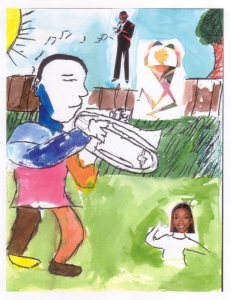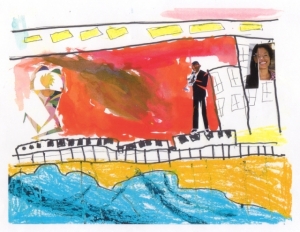
|
Lesson
Plan for
Romare Bearden
Grades 3 to 8
An
Interactive Reproduction Presentation Followed by a Slide
Presentation
Art Aware
1701 South 4th Street
Camden, NJ 08014
(856) 365-0831
artaware@hotmail.com
|
Click
on any image for black & white version.
Objective:
Students will be able to identify artwork by Romare Bearden and to
explain his techniques.
Skills:
Students will learn to look for cut and pasted papers and images,
paint, ink and pencil designs, shapes and spaces and the rhythms therein.
They will learn to listen to music by looking at Bearden’s work
and learn to see Bearden’s work by listening to jazz.
Materials:
- Cassette/CD
player
-
Cassette/CD of Jazz (see Resources #5)
-
Reproductions and Slides
Procedure:
As students enter the classroom, “Autumn” will be played
and as they leave “Carolina Shout” will be played.
Romare
Bearden was an African American artist who loved life. He was born
in 1911 in Charlotte, N.C. and moved to New York City when he was
four years old. His family settled in Harlem and many famous writers,
scholars and artists visited his home.
As a
boy he often visited his relatives in Pittsburgh and Mecklenburg County,
N.C. He graduated from New York University with a degree in Science
in Education. He got a job as a case worker in the New York City Department
of Social Services which he kept for many decades.
He always
loved art and studied art in college and at night school after he
graduated.
After a full day’s work, he would come home and work at his
art at night.
“Tomorrow
I May Be Far Away”
You can see in “Tomorrow I May Be Far Away” a man (perhaps
Bearden himself) looking back on his childhood memories with his grandmother
in North Carolina. Can you see the wall of a wooden shack? How did
he make this wall? There are three main characters in this work. Can
you describe them? Look at the hands. Are they a mixture of white
and black people’s hands? Can you find the train which Bearden
uses many times to show people traveling from place to place which
also represents change and a progression through time?
When
you look at the two large faces, do they seem to move? Do the cut-out
pieces seem to slide like the notes in a piece of jazz music?
Bearden
wasn’t interested in representational art. If he wanted an exact
replica of something all he had to do was use his camera. He wanted
FEELING in his artwork. How do you think the seated figure is feeling?
Does the title help in describing his feeling?
"Captivity
and Resistance"
Romare Bearden was a people person. Especially an African American
people person! To commemorate the opening of the African American
Museum in Philadelphia in 1976, Bearden created a huge fabric collage
called “Captivity and Resistance.” The central figure,
Cinque, is the leader of the slave rebellion aboard the Amistad. Do
you see Frederick Douglas, Harriet Tubman, John Brown? So you see
black soldiers in Confederate uniforms being commanded by a white
Union officer? In the scale at the left, who is the more weighty of
the two, the white man or the black man?
“The
Lamp”
To commemorate the ending of segregation in public schools, Bearden
made “The Lamp.” Two young people with mask-like faces
are reading a book. Bearden shows the lamp and book (education !),
lighting the darkness of the past leading to a brighter future.
“Odysseus Enters the Room Disguised as an Old Man” (PDF, see p.10)
How Bearden loved books! In “Odysseus Enters at the Door Disguised
as an Old Man”, he goes back to a story 2,800 years old called
“The Odyssey” by Homer. (Go to your library and you will
find hundreds of references to the story!)
Here
is the part of the story captured in his artwork.
For
ten years, Penelope, Odysseus’ wife, has been holding off the
suitors - the men wanting to marry her and take over her Kingdom of
Ithaca, believing her husband would return. She tells the aggressive
suitors that she will marry one of them when she finishes weaving
the cloth on her loom. She unravels it each night and starts over
each day to delay the time when she will have to marry one of them.
Finally, unbeknownst to Penelope, Odysseus returns on the ship in
the background, disguised as an old man (otherwise the suitors would
kill him). He makes himself known to his son and together they plot
the overthrow of the suitors. (His old cat is the only one who recognizes
him.)
Penelope
realizes she must give in to the suitors’ demands and she tells
them she will marry whoever has the strength to pull back her husband’s
bow (in upper left corner of painting) and shoot an arrow through
a series of rings. The old man is the only one able to do this. He
shoots all the arrows and kills the suitors and regains his kingdom.
He had
seen a painting of this story in a book called “Penelope and
Her Suitors,” which he liked very much, done in 1509 by Pintorricheo,
an Italian artist. Bearden did his own version of the story with black
people. Can you find the key people and objects of the story? Odysseus
is way back on the right, in the doorway. Penelope, the loom and the
cloth she’s weaving, the evil suitors, the bow and arrow, the
cat, the ship that carried Odysseus home are all there as well.
”The
Street”
Bearden continues to call attention to black people, in this case,
to African Americans living in New York City. The original collage
has areas of color: the buildings, a sweater, a red collar, an orange-brown
African mask-like face. Bearden enlarged his artwork in black
and white and studied the difference without the color. The faces
popped out more! With the color, it looks a little softer, more three-dimensional.
What
do you think? Do you see the guitar front and center? Do you see a
woman’s face that looks like she knows “the blues?”
“J-Mood” (Scroll the "Romare Bearden Gallery" to find the image)
Can you hear the trumpet in “J-Mood?” Can you imagine
that purple dancer moving to the beat? Look at the waves of melody
in the background, the space between notes in the white areas of color,
the white sleeve button, the white slash on the top of the dancer’s
head and under her thigh and finally, do you see the two stars –
red on the left and yellow on the right – maybe representing
the highest, brassiest notes being played. Listen to this piece of
music on Branford Marsalis’ CD while looking at the artwork.
“Berkeley
– Life of the City”
Bearden loved to study. Imagine how he must have studied about the
history of the city to complete this commission. Bearden loved people
and it shows in this very large collage. Do you recognize any persons,
places or things? Which people attract you? Can you identify any people
by race? Can you find one place where Bearden represents all the peoples
of the world? Do you see the train or other modes of transportation
signifying a journey and a passage of time? How diverse is the City
of Berkeley in terms of race, employment, age, geography, etc.
“The
Artist with Painting and Model”
This is Bearden’s only known self-portrait. But his face is
blank. What we see is his life’s work of drawing, painting,
collage and studying. Do you see a part of a 14th century Renaissance
painting? Do you see his brushes, pencils, fabric, watercolor, collage
pieces? Which figure represents Africa and which African American?
The painting on the easel is a version of one Bearden did 40 years
earlier. Do you see the gray fabric on the chair and the place where
there’s a cut-out of his hand that is resting on the top of
the picture frame?
Bearden chose hot to draw his own face, perhaps because he saw himself
in the faces and place of so many other people. Bearden did very few
pieces of artwork without people in them.
Slide
Presentation
You
can see in the following slides how Bearden remembered people and
places in his artwork.
Pittsburgh
Memories:
“Farewell
Eugene” 1978 - He remembered his childhood friend,
Eugene Bailey, who died when Bearden was a teenager.
“Pittsburgh
Memories” 1984 – He remembered the boarding
house his step grandfather owned and his grandmother, rubbing cocoa
butter on the burns of the boarders who had migrated from the South
and found jobs working in the steel mills.
Mechlenberg
County:
“Tomorrow
I May Be Far Away” 1966 – He remembered the
shacks there.
“Madeline
Jones’ Wonderful Garden” 1977 – He
remembered all the gardens there.
“Prevalence
of Ritual: The Conjur Women” 1964 – He remembers
the women who had special magical powers.
Africa:
“Prevalence
of Ritual: The Baptism” 1964 – Bearden honored
rituals in Africa and in the United States by depicting baptisms with
African masks featured.
Civil
Rights:
“Now
the Dove and Leopard Wrestle” 1946 – What
you really see is a bull and a horse wrestling. Guess who will win?
This symbolizes powerlessness in the face of powerful, evil forces
like racism.
New
York City:
“The
Block II” 1972 - Bearden painted all the people
he imagined, he knew and he read about.
“Spring
Way” 1964 – He painted the places where city
people lived.
“The
Street” Photostat 1964 – He painted the lifestyles
of many inner city folk of all ages.
“City
Lights” 1970 (PDF, see p.51)- He painted the music, the rhythms,
the beats that were everywhere in the city.
“Midtown
Sunset” 1981 – This is one of the few works
that has no people. He painted the city during the day and at night.
European
Influence:
“Odysseus Enters the Room Disguised as an Old Man” 1977 (PDF, see p.10) – Bearden studied and remembered ancient stories and European
artists.
Harlem,
The Apollo Theatre, The Savoy:
“Of
the Blues - Carolina Shout” 1974 – Bearden
combined the sacred and profane in this baptism collage: there is
the baptism ritual and the famous jazz song and dancing.
“Of
the Blues – At the Savoy” 1974 – With
great skill, he created dancers floating in space. He believed that
when you sang or played the Blues, you always felt better.
Island
of St. Martin:
“In
a Green Shade” – He painted the island his
wife was born on which he loved so much.
Evaluation:
Students will be asked to recall and comment upon the reproductions
and slides that reflected Bearden’s life and the techniques
he used to give them a visual and musical experience.
Lesson
Plan Resources
Lesson Plan: Bearden Art-Making
Workshop
Copyright
© 2005 Art Aware. Return
to Romare Bearden.
Go to Art Aware.
Posted
6 February 2005, updated
December 1, 2013
http://www.artaware.org/beardenlessonplan.htm |

